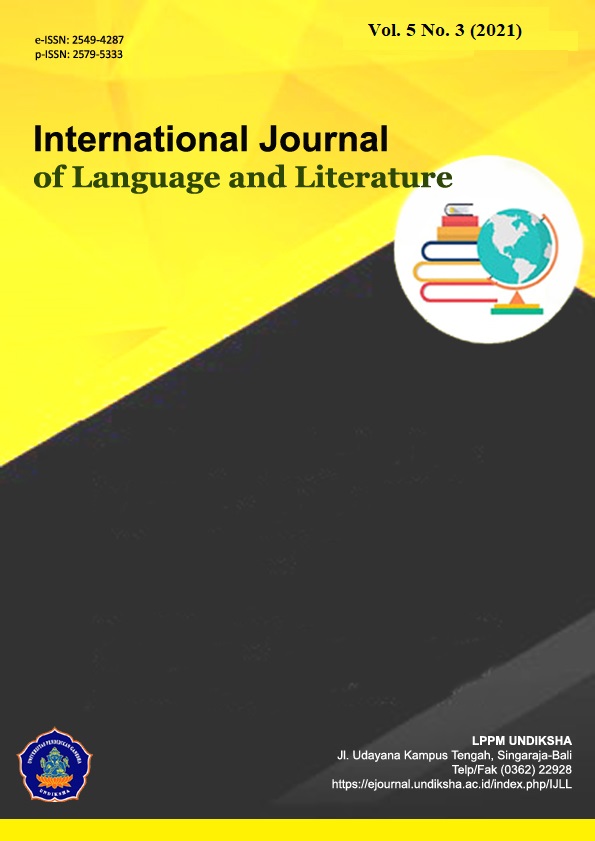STUDENTS’ E-LEARNING READINESS IN REMOTE TEACHING CONTEXT
DOI:
https://doi.org/10.23887/ijll.v5i3.32623Keywords:
EFL, E-learning, readiness, Remote teachingAbstract
The study aims to analyze students e-learning readiness which used a mixed-method research design. There were 30 students as the subject of this study. The reliability of this research was 0.70. This study used an online learning readiness questionnaire. For questionnaire responses, the researcher used Aydin and Tasci’s readiness measurement model to know the score of students’ e-learning readiness. Besides that, Interview guide. The interview responses were analyzed using Interactive Model Analysis. Therefore, the students e-learning score was Mo = 3.76. The interview result showed the availability of media and the flexibility of e-leaning as the supporting factor, while the facilities in e-learning as the limiting factor. It can be concluded that students e-learning readiness is ready buy still need improvement on technology readiness, people readiness, innovation readiness, and self-development readiness This research was rewarding to comprehend students’ e-learning readiness as well as supporting an limiting in implementing e-learning in remote teaching. Several recommendations are proposed for vocational school are infrastructure provision in e-learning and socialization to use e-learning.
References
Alam, N. (2014). Potensi Penggunaan Koneksi Internet Instansi Pemerintah Bersama Masyarakat di Kota Makassar The Potential Use of the Internet Connection of Government Agencies with Citizen in Makassar. 17(3), 189–196.
Anderson. (2018). The Theory and Pratice of Online Learning. Joural of Physics, 1–14.
Aydin, C. H., & Tasci, D. (2016). Measuring Readiness for e-Learning : Reflections from an Emerging Country Cengiz Hakan Ayd ı n. 8, 244–257.
Budiaman, B. (2017). The importance of Media in E-Learning Process. Jurnal Sejarah Lontar, 7(2), 50. https://doi.org/10.21009/lontar.072.05 DOI: https://doi.org/10.21009/LONTAR.072.05
Chapman. (2020). Senior School Remote Teahing and Leaarning Policy in the Event o Self Isolation and/or Temorary School Closure. 2, 147–156.
Creswell, J. W. (2012). Educational research: Planning, conducting and evaluating quantitative and qualitative research. Pearson Education.
Daniel, G. (2019). The Use of Laptop for E-learning Process. Journal of Chemical Information and Modeling, 53(9), 1689–1699.
David. (2004). An assessment of e-learning readiness at Open University Malaysia. -, 1017–1022.
Fajri, S. Al. (2018). Pengukuran Tingkat Kesiapan Penerapan E-Learning Di Smk N 1 Banyumas. Journal of Education and Learning, xv, 160 p.
Faslah, R., Santoso, H. B., Ilmu, F., & Universitas, K. (2017). Analisis Kesiapan Implementasi E-Learning Menggunakan E-Learning Readiness Model. 3(2), 113–120. DOI: https://doi.org/10.31961/positif.v3i2.431
Guragin. (2017). E-learning for Student. Journal of Education, 2(1), 11–18. DOI: https://doi.org/10.1016/j.ece.2017.03.001
Hadijah, S. (2016). Teaching by Using Video: Ways to Make it More Meaningful in EFL Classrooms. Proceedings of the Fourth International Seminar on English Language and Teaching ISELT-4, October, 307–315.
Hamalik. (2018). The Use of Teaching Media in the Teaching and Learning Process. Journal of Education and Learning, 1–21. http://library1.nida.ac.th/termpaper6/sd/2554/19755.pdf
Handayani, J. A., Al-Bahij, A., Bahar, H., & ... (2020). Analisis Kesiapan Pembelajaran Daring Peserta Didik Kelas I Sekolah Dasar Negeri Ciputat 04 di Masa Pandemi Covid-19. … Nasional Penelitian LPPM …. https://jurnal.umj.ac.id/index.php/semnaslit/article/view/7868
Jamal, S., Kesiapan, A., Saat, P. E., Jamal, S., & Tambelangan, S. M. K. N. (2020). Pandemi Covid-19 Di Smk Negeri 1 Tambelangan Analysis Of E-Learning Readiness During The Covid-19 Pandemic At Smk Negeri 1 Tambelang. 8, 16–22. DOI: https://doi.org/10.26858/jnp.v8i1.13561
Jurado, G. (2018). Barriers to a wider Implementation of LMS in Higher Education: a Swedish case study,. Web-Seminar Nasional, January, 129–135.
Kurnia. (2020). Penetrasi internet di Bali paling tinggi. Beritagar.Id.
Kurnia, D. (2017). The Use of Facility for Learning Process. Вестник Росздравнадзора, 4, 9–15.
Lambert. (2013). Kemampuan Siswa Kelas XI SMK.... (Mutiara Armita, Yusri Yusuf, & Ridwan Ibrahim) 49. 49–61.
Lestari, Y. (2020). Analisis Tingkat Kesiapan Penerapan E-Learning Pada Prodi Pendidikan Biologi Fakultas Tarbiyah Dan Keguruan Uin Ar-Raniry Banda Aceh. Journal of Education, 1–40.
Prajana, A. (2017). Pemanfaatan Aplikasi Whatsapp Dalam Media Pembelajaran Di Uin Ar-Raniry Banda Aceh. In Jurnal Pendidikan Teknologi Informasi (Vol. 1, Issue 2). DOI: https://doi.org/10.22373/cs.v1i2.1980
Schubert, Petra; Risch, D. (2006). Collaborative Electronic Commence Technology and Research. 10(01), 1–7.
Stanley. (2020). The Effect of E-Learning Based on Schoology and Student Interest to Metacognitive Thinking Skill of Vocational High School Students in Archival Subject. International Journal of Research and Review, 6(Januari), 397–404.
Suprayekti. (2018). Intergrasi Teknologi ke Dalam Kurikulum. Perspektif Ilmu Pendidikan, 24, 457–462. https://doi.org/10.1016/j.sbspro.2014.02.062 DOI: https://doi.org/10.21009/PIP.242.9
Wasik, A. (2018). Analisis Hasil Belajar dengan Nilai Indeks Prestasi Kumulatif (IPK). Islamic Akademika, 5(2), 29–39.
Yuwono, K. T., & Sujono, H. D. (2018). The Effectiveness of E-Learning: A Meta-Analysis. Journal of Physics: Conference Series, 1140(1). https://doi.org/10.1088/1742-6596/1140/1/012024 DOI: https://doi.org/10.1088/1742-6596/1140/1/012024
Downloads
Published
How to Cite
Issue
Section
License
IJLL Journal provides immediate open access to its content on the principle that making research freely available to the public to supports a greater global exchange of knowledge.

This work is licensed under a Creative Commons Attribution-ShareAlike 4.0 International License








